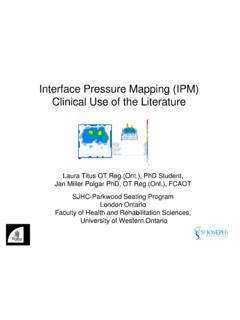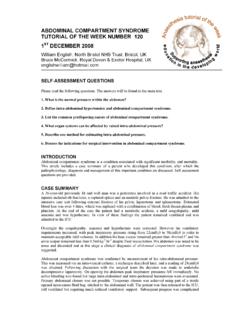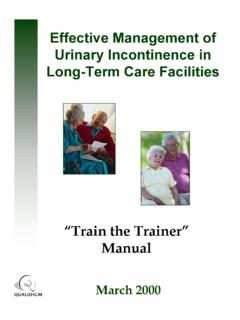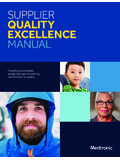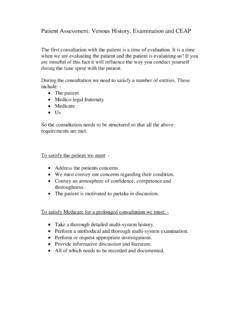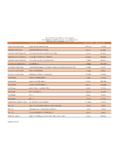Transcription of Assessment Checklist for the Application of Dynamic Tilt ...
1 Assessment Checklist for the Application of Dynamic Tilt-in-Space as Temporary Seating The following assessments outline the evaluations used to determine when an individual requires the use of Dynamic tilt-in-space for temporary seating. Each of these evaluations must be completed prior to placing an individual in a tilt wheelchair or on the tilt waitlist. If Dynamic tilt-in-space becomes required for permanent seating, additional assessments must occur including a thorough postural evaluation (mat Assessment ) and equipment trials prior to prescription. Assessment 1: SCREEN FOR PHYSICAL STATUS & MEDICAL CONDITIONS The 2 main objectives for the use of Dynamic tilt-in-space as temporary seating are: 1. Prevention and management of skin breakdown 2. Establish and increase sitting tolerance 3. Provide postural support to maintain skeletal alignment As a result, the main factors that an individual should be screened for to determine if Dynamic tilt-in-space is required include: 1.
2 Immobility or altered mobility 2. Lack of or altered sensation over weight bearing surfaces in sitting 3. Negative physiological responses in a fully upright position Conditions that may impact mobility Neurological diagnoses stable or progressive ( SCI, MS, CVA) Musculoskeletal injury ( multiple fractures, amputations) Altered cognition, depression, or poor motivation ( dementia) Any condition that leads to decreased strength ( frail elderly) Any condition that leads to decreased balance in sitting Conditions that may impact sensation Neurological diagnosis Peripheral neuropathy Conditions that result in negative physiological responses in sitting Neurological diagnosis ( Autonomic Dysreflexia) Any condition that leads to dizziness in sitting ( postural hypotension) Any condition that leads to pain in sitting ( pelvic fractures) If an individual has a primary or secondary medical condition that falls under any of the 3 categories listed above, a Dynamic tilt-in-space wheelchair should be considered.
3 Move to Assessment 2 below for further evaluation to confirm the need for a Dynamic tilt-in-space wheelchair. Last updated: December 2012 Assessment 2: ABILITY TO SIT AGAINST GRAVITY/TRUNK BALANCE This evaluation allows the clinician to determine an individual s ability to maintain an upright posture against the influence of gravity. Evaluate an individual s balance when sitting on a solid surface ( plinth or hospital bed with mattress firmed) with feet and thighs fully supported to determine which category they fit under. NOTE: A change in an individual s cognition and/or fatigue may prevent them from reliably and effectively performing the movements outlined below consistently over the course of the day. If this is the case, a Dynamic tilt-in-space wheelchair will likely be required. Non-sitter Individual is unable to be placed into a sitting position at all due to medical condition ( unstable fractures, pain) Dynamic tilt-in-space is not appropriate at this time Consider use of a neuro chair if positioning outside the bed is required Re-evaluation to discontinue use of neuro chair should occur as soon as individual s medical condition stabilizes Dependent sitter Requires full external support to sit ( cervical SCI)
4 No active strength or balance to hold themselves upright against gravity Individual would completely lose their posture in sitting if trunk wasn t fully supported externally Dynamic tilt-in-space IS required Hands-dependent sitter Requires use of upper extremities at all times to sit Individual can hold themselves upright against gravity without external support by using upper extremities to balance but fatigues quickly If asked to raise upper extremities away from sitting surface individual would be unable to maintain balance unless they had external support Maintaining balance in sitting through use of upper extremities is fatiguing Tend to demonstrate a collapsed posture out of midline (posterior pelvic tilt and trunk kyphosis) to gain a more stable base of support to compensate for lack of balance Dynamic tilt-in-space LIKELY required, but further evaluation ( Assessment 3) necessary to confirm 2 Hands-free static sitter Independently capable of holding themselves upright against gravity without the use of external supports or upper extremities for balance If asked to reach in any direction away from static sitting position they cannot maintain balance without the use of upper extremities or external support Likely prone to fatigue when holding themselves upright in a static sitting position without use of upper extremities or external supports Tend to demonstrate a collapsed posture out of midline (posterior pelvic tilt and trunk kyphosis) to gain a more stable base of support to compensate for lack of balance Dynamic tilt-in-space MAY be required, but further evaluation ( Assessment 3)
5 Necessary to confirm Hands-free Dynamic sitter Individual is capable of independently holding themselves upright against gravity without the use of upper extremities or external support If asked to reach in any direction away from a static sitting position ( lean to the right or left, lean forward or backward) they can maintain balance without use of upper extremities or external support AND can return to midline after reaching NOTE: some individuals may fluctuate between a hands-free Dynamic sitter and hands-free static sitter depending on which direction they are asked to reach and/or fatigue Dynamic tilt-in-space NOT LIKELY required, but further evaluation ( Assessment 3) necessary Those individuals classified as non-sitters do NOT meet the criteria for Dynamic tilt-in-space. Their condition should be monitored closely and reassessment should occur once they are medically stable enough to be moved into a sitting position.
6 Those individuals classified as dependent sitters meet the criteria for Dynamic tilt-in-space. Skip past Assessment 3 and move directly to Assessment 4 for the next required evaluation. Those individuals classified as hands-dependent, hands-free static, or hands-free Dynamic sitters require further evaluation before it can be determined if a Dynamic tilt-in-space wheelchair is necessary. Move to Assessment 3 below for the next required evaluation. 3 Assessment 3: EVALUATION OF PRESSURE REDISTRIBUTION (WEIGHT SHIFTING) MOVEMENTS IN SUPPORTED SITTING This evaluation will allow clinicians to determine how effectively an individual can move or shift their weight in a sitting position in order to provide offloading and pressure redistribution away from weight bearing surfaces in sitting. In order for someone to be effectively offloaded there should be complete removal of pressure from specific weight bearing surfaces of the body.
7 NOTE: A change in an individual s cognition and/or fatigue may prevent them from reliably and effectively performing the movements outlined below consistently over the course of the day. If this is the case, a Dynamic tilt-in-space wheelchair will likely be required. There are 6 primary bony landmarks of the pelvis that are at risk for skin breakdown in sitting. These include: Greater trochanters (GT s) CoccyxSacrumIschial tuberosities(IT s) To palpate the IT s, coccyx and sacrum when an individual is sitting, use a slider glove or regular slider sheet to allow your hand to move under the individual s buttocks without resistance so that it sits between the person s body and the support surface they are sitting on. With your palm up, locate the IT s on each side of the buttocks; they will be somewhat prominent on most people, but will feel particularly bony on individuals who have lost muscle mass in that area.
8 Typically there is only ~4-6 of space between each of the IT bones. The coccyx and sacrum can be landmarked at the posterior-midline location of the buttocks. The sacrum is a pretty flat bony area that connects the pelvis to the spine approximately at the height of the posterior superior iliac spines (PSIS). The coccyx is a very small bone that will be located just distal to the sacrum. It can also feel particularly bony on individuals who have lost muscle mass in that area. 4 If the individual sits with a relatively neutral pelvic posture, the IT s should be the lowest bony prominences in the pelvic region. Any time an individual s posture deviates away from neutral and into an obliquity, the IT on the low side of the obliquity will be at higher risk of taking more concentrated pressure and/or bottoming out on the support surface that is in use. If the individual sits with a relatively neutral pelvic posture they may not actually weight bear on their sacrum and coccyx at the cushion interface.
9 This is more likely with those individuals who are prone to a posterior pelvic tilt. These 2 bony areas may however weight bear against the individual s back support surface in a sitting position. To locate the GT s, place hands laterally along the sides of an individual s hips towards the pelvic region. With palms facing inwards the GT s can be located just distal and lateral to the pelvic area. If an individual sits with a relatively neutral pelvic posture the GT s should not be primary weight bearing surfaces in sitting. The risk of concentrated pressure in this area occurs more frequently if the seat base is too narrow for the individual and they are pressing against the arm supports. There is a chance, however, that an individual may weight bear on the lower GT if their pelvic posture has significantly deviated away from neutral and into an obliquity. Each of these bony landmarks should be palpated when a pressure redistribution movement occurs to confirm whether there is effective offloading with each movement.
10 A movement will be considered effective if the individual can redistribute their weight enough to completely eliminate all pressure and weight bearing away from the support surface they are sitting on. The clinician should be able to feel clearance on the back side of their hand while landmarking at the bony area with the palm side of their hand. Individuals may require more than one movement to occur to make sure all areas get offloaded in sitting. For the weight shifting movement to be effective, the individual must be capable of performing the movement(s) every 15 minutes and holding that movement for a minimum of 1 minute. Each movement must be reliable, effective, and consistently performed over the course of the day to ensure adequate pressure management. 5 With your client sitting in a wheelchair or arm chair with thighs and feet full supported, evaluate the following movements and confirm how effective they are for offloading pressure to specific bony landmarks: Movement Instruction/Description Areas that should be offloaded and palpated Full push-up Direct client to use their upper extremities to push down against the armrests (or rear wheels) to try and lift their buttocks up away from the sitting surface Coccyx Sacrum Right and left IT s Right and left GT s Partial push-up Same instruction as above Right and left GT s Partial or full offloading of right and left IT s Partial or full offloading of coccyx Partial or full offloading of sacrum Forward lean Direct client to lean their trunk forward towards their thighs as far as they can go without losing balance.
